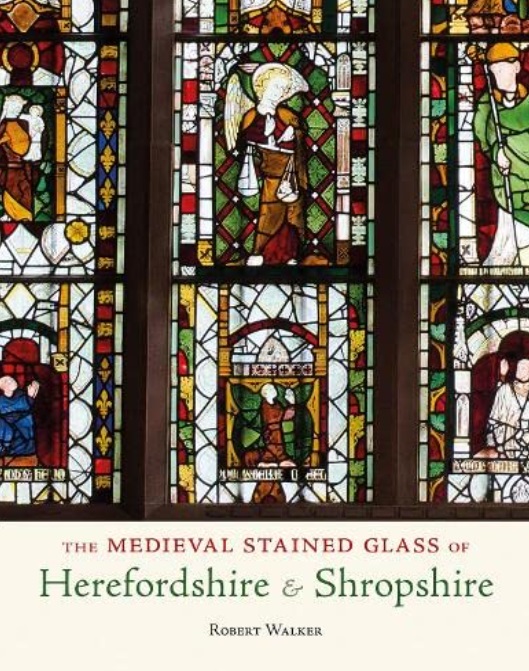The Medieval Stained Glass of Herefordshire and Shropshire

|
| The Medieval Stained Glass of Herefordshire and Shropshire, Robert Walker, Logaston Press, 2023, 286 pages, extensively illustrated mostly in colour, paperback. |
The Logaston Press has an excellent catalogue of books on the history, art, architecture, culture and people of the Welsh Marches. Robert Walker’s comprehensive new book on its medieval glass is an addition of considerable value to architectural historians and glass aficionados, as well as the interested amateur.
The history of stained glass in England is clouded with a series of significant problems: the rarity of medieval records, the sketchiness of early recording, 16th- and 17th-century iconoclasm, 18th-century neglect and 19th-century restorations with lost or inadequate records. Neither historic nor modern studies in the Marches have been comprehensive, a matter Walker’s book seeks to redress.
The book is divided into a general description of the subject entitled ‘The history and iconography of the stained glass in the Diocese of Hereford’ (the diocese includes much of Shropshire) and a gazetteer in which the glass of individual churches is described. The history section deals first with the art of glassmaking itself, and then with what little is known of the glaziers and glassmaking sites, and the rather better evidence of the patrons of early glass. In this and the subsequent chronological sections he comments constructively on the work of previous writers on the subject. He draws interesting comparisons from outside the survey area, and includes references to glass that is now located elsewhere.
The period covered by the book is considerably wider than can be construed from the term medieval. Of necessity in a review of the heritage that remains to us, the later history of the glass’s recording, removal and restoration must also be recorded. Hence the text frequently forges into the events of later periods.
The gazetteer is nicely handled, with each location at which medieval glass has been identified being accorded a description proportionate to its scale and importance. The places with more substantial descriptions, such as Abbey Dore, Eaton Bishop, Hereford Cathedral, Ledbury and Ludlow, include considerable cross-referencing and comparisons with other sites within the scope of the book as well as those further away.
The book is lavishly furnished with high-quality illustrations sufficiently detailed to see precisely the points being made in the text. The windows requiring the most detailed explanations are separated into text boxes for easy location and reference. The extent of the research is prodigious, with details of what is known about each window set out with great clarity.
While there is no problem locating all the places covered by the book, its structure is slightly confusing. The book’s title and map suggest that it covers the two modern ceremonial counties, but the preface makes clear that the emphasis is diocesan. The map, on the other hand, has a diocesan boundary on its eastern side and a county boundary on its western one. The parts of Shropshire not in Hereford Diocese are confined to an appendix in which four locations that properly should have been in the main gazetteer are misplaced. But these are minor quibbles about a scholarly and authoritative book.
A reference book rather than a handbook, it is very nicely produced. It should be on the shelves of anyone interested in the cultural heritage of the Marches and must surely have the effect of increasing interest in this previously neglected topic.
This article originally appeared as ‘A window on the Marches’ in the Institute of Historic Building Conservation’s (IHBC’s) Context 177, published in September 2023. It was written by James Caird.
--Institute of Historic Building Conservation
Related articles on Designing Buildings
- Conservation.
- Conserving Canterbury Cathedral's Great South Window.
- Conserving structures in historic designed landscapes.
- Crittall metal windows.
- Environmental protective glazing.
- Glass.
- Glazing.
- Heritage.
- Historic environment.
- Historic steel-framed windows.
- IHBC articles.
- IHBC.
- Ordinary people in stained glass.
- The history of glass.
- The secret life of the Georgian garden.
- Types of glass.
IHBC NewsBlog
Images from inside a Grade II listed hotel show the scale of its collapse
The Corbett Arms in Tywyn has fallen into serious disrepair.
Old Sarum fire in listed (& disputed) WW1 Hangar - Wiltshire Council has sought legal advice after fire engulfed a listed First World War hangar that was embroiled in a lengthy planning dispute.
UK Antarctic Heritage Trust launches ‘Virtual Visit’ website area
The Trust calls on people to 'Immerse yourself in our heritage – Making Antarctica Accessible'
Southend Council pledge to force Kursaal owners to maintain building
The Council has pledged to use ‘every tool in the toolbox’ if urgent repairs are not carried out.
HE’s Research Magazine publishes a major study of the heritage of England’s suburbs
The article traces the long evolution of an internal programme to research 200 years of suburban growth
IHBC Context 183 Wellbeing and Heritage published
The issue explores issues at the intersection of heritage and wellbeing.
SAVE celebrates 50 years of campaigning 1975-2025
SAVE Britain’s Heritage has announced events across the country to celebrate bringing new life to remarkable buildings.
IHBC Annual School 2025 - Shrewsbury 12-14 June
Themed Heritage in Context – Value: Plan: Change, join in-person or online.
200th Anniversary Celebration of the Modern Railway Planned
The Stockton & Darlington Railway opened on September 27, 1825.
Competence Framework Launched for Sustainability in the Built Environment
The Construction Industry Council (CIC) and the Edge have jointly published the framework.














